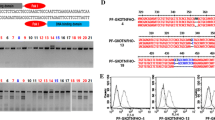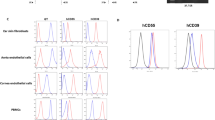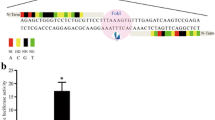Abstract
Pig-to-human organ transplantation has drawn attention in recent years due to the potential use of pigs as an alternative source of human donor organs. While GGTA1 knockout (GTKO) can protect xenografts from hyperacute rejection, complement-dependent cytotoxicity might still contribute to this type of rejection. To prolong the xenograft survival, we utilized a T2A-mediated pCMV-hCD55-T2A-hCD59-Neo vector and transfected the plasmid into GTKO Diannan miniature pig fetal fibroblasts. After G418 selection combined with single-cell cloning culture, four colonies were obtained, and three of these were successfully transfected with the hCD55 and hCD59. One of the three colonies was selected as donor cells for somatic cell nuclear transfer (SCNT). Then, the reconstructed embryos were transferred into eight recipient gilts, resulting in four pregnancies. Three of the pregnant gilts delivered, yielding six piglets. Only one piglet carried hCD55 and hCD59 genetic modification. The expression levels of the GGTA1, hCD55, and hCD59 in the tissues and fibroblasts of the piglet were determined by q-PCR, fluorescence microscopy, immunohistochemical staining, and western blotting analyses. The results showed the absence of GGTA1 and the coexpression of the hCD55 and hCD59. However, the mRNA expression levels of hCD55 and hCD59 in the GTKO/hCD55/hCD59 pig fibroblasts were lower than that in human 293T cells, which may be caused by low copy number and/or CMV promoter methylation. Furthermore, we performed human complement-mediated cytolysis assays using human serum solutions from 0 to 60%. The result showed that the fibroblasts of this triple-gene modified piglet had greater survival rates than that of wild-type and GTKO controls. Taken together, these results indicate that T2A-mediated polycistronic vector system combined with SCNT can effectively generate multiplex genetically modified pigs, additional hCD55 and hCD59 expression on top of a GTKO genetic background markedly enhance the protective effect towards human serum-mediated cytolysis than those of GTKO alone. Thus, we suggest that GTKO/hCD55/hCD59 triple-gene-modified Diannan miniature pig will be a more eligible donor for xenotransplantation.





Similar content being viewed by others
References
Klymiuk, N., Aigner, B., Brem, G., & Wolf, E. (2010). Genetic modification of pigs as organ donors for xenotransplantation. Molecular Reproduction and Development, 77, 209–221.
Xiang, Y.-T., Meng, L.-R., & Ungvari, G. S. (2016). China to halt using executed prisoners’ organs for transplants: A step in the right direction in medical ethics. Journal of Medical Ethics, 42, 10.
Pan, W., Zhang, G., Qing, Y., Li, H., Cheng, W., Wang, X., et al. (2015). evaluation of cloning efficiency based on the production of cloned diannan miniature pigs. RRJMB, 4, 1–7.
Chen, F. X., Tang, J., Li, N. L., Shen, B. H., Zhou, Y., Xie, J., et al. (2003). Novel SLA class I alleles of Chinese pig strains and their significance in xenotransplantation. Cell Research, 13, 285–294.
Cheng, W., Zhao, H., Yu, H., Xin, J., Wang, J., Zeng, L., et al. (2016). Efficient generation of GGTA1-null Diannan miniature pigs using TALENs combined with somatic cell nuclear transfer. Reproductive Biology and Endocrinology, 14, 77.
Ekser, B., Ezzelarab, M., Hara, H., van der Windt, D. J., Wijkstrom, M., Bottino, R., et al. (2012). Clinical xenotransplantation: The next medical revolution? The lancet, 379, 672–683.
Yang, Y. G., & Sykes, M. (2007). Xenotransplantation: Current status and a perspective on the future. Nature Reviews Immunology, 7, 519–531.
Phelps, C. J., Koike, C., Vaught, T. D., Boone, J., Wells, K. D., Chen, S. H., et al. (2003). Production of alpha 1,3-galactosyltransferase-deficient pigs. Science, 299, 411–414.
Lai, L., Kolber-Simonds, D., Park, K. W., Cheong, H. T., Greenstein, J. L., Im, G. S., et al. (2002). Production of alpha-1,3-galactosyltransferase knockout pigs by nuclear transfer cloning. Science, 295, 1089–1092.
Cowan, P. J., Aminian, A., Barlow, H., Brown, A. A., Chen, C. G., Fisicaro, N., et al. (2000). Renal xenografts from triple-transgenic pigs are not hyperacutely rejected but cause coagulopathy in non-immunosuppressed baboons. Transplantation, 69, 2504–2515.
Ekser, B., Kumar, G., Veroux, M., & Cooper, D. K. (2011). Therapeutic issues in the treatment of vascularized xenotransplants using gal-knockout donors in nonhuman primates. Current Opinion in Organ Transplantation, 16, 222–230.
Dor, F. J., Kuwaki, K., Tseng, Y. L., Shimizu, A., Houser, S. L., Yamada, K., et al. (2005). Potential of aspirin to inhibit thrombotic microangiopathy in alpha 1,3-galactosyltransferase gene-knockout pig hearts after transplantation in baboons. Transplantation Proceedings, 37, 489–490.
Kuwaki, K., Tseng, Y. L., Dor, F. J., Shimizu, A., Houser, S. L., Sanderson, T. M., et al. (2005). Heart transplantation in baboons using alpha 1,3-galactosyltransferase gene-knockout pigs as donors: Initial experience. Nature Medicine, 11, 29–31.
Tseng, Y. L., Kuwaki, K., Dor, F. J., Shimizu, A., Houser, S., Hisashi, Y., et al. (2005). Alpha 1,3-galactosyltransferase gene-knockout pig heart transplantation in baboons with survival approaching 6 months. Transplantation, 80, 1493–1500.
Chen, G., Qian, H., Starzl, T., Sun, H., Garcia, B., Wang, X., et al. (2005). Acute rejection is associated with antibodies to non-Gal antigens in baboons using Gal-knockout pig kidneys. Nature Medicine, 11, 1295–1298.
Schroder, C., Pfeiffer, S., Wu, G., Zorn, G. L. 3rd, Ding, L., Allen, C., et al. (2003). Effect of complement fragment 1 esterase inhibition on survival of human decay-accelerating factor pig lungs perfused with human blood. The Journal of Heart and Lung Transplantation: The Official Publication of the International Society for Heart Transplantation, 22, 1365–1375.
Burdorf, L., Stoddard, T., Zhang, T., Rybak, E., Riner, A., Avon, C., et al. (2014). Expression of human CD46 modulates inflammation associated with GalTKO lung xenograft injury. American Journal of Transplantation: Official Journal of the American Society of Transplantation and the American Society of Transplant Surgeons, 14, 1084–1095.
Wiebe, K., Poeling, J., Meliss, R., Loss, M., Winkler, M., Steinhoff, G., et al. (2001). Improved function of transgenic pig lungs in ex vivo lung perfusion with human blood. Transplantation Proceedings, 33, 773–774.
Westall, G. P., Levvey, B. J., Salvaris, E., Gooi, J., Marasco, S., Rosenfeldt, F., et al. (2013). Sustained function of genetically modified porcine lungs in an ex vivo model of pulmonary xenotransplantation. The Journal of Heart and Lung Transplantation: The official Publication of the International Society for Heart Transplantation, 32, 1123–1130.
Daggett, C. W., Yeatman, M., Lodge, A. J., Chen, E. P., Van Trigt, P., Byrne, G. W., et al. (1997). Swine lungs expressing human complement-regulatory proteins are protected against acute pulmonary dysfunction in a human plasma perfusion model. The Journal of Thoracic and Cardiovascular Surgery, 113, 390–398.
Kulick, D. M., Salerno, C. T., Dalmasso, A. P., Park, S. J., Paz, M. G., Fodor, W. L., et al. (2000). Transgenic swine lungs expressing human CD59 are protected from injury in a pig-to-human model of xenotransplantation. The Journal of Thoracic and Cardiovascular Surgery, 119, 690–699.
Rosengard, A. M., Cary, N. R., Langford, G. A., Tucker, A. W., Wallwork, J., & White, D. J. (1995). Tissue expression of human complement inhibitor, decay-accelerating factor, in transgenic pigs. A potential approach for preventing xenograft rejection. Transplantation, 59, 1325–1333.
Rosengard, A. M., Cary, N., Horsley, J., Belcher, C., Langford, G., Cozzi, E., et al. (1995). Endothelial expression of human decay accelerating factor in transgenic pig tissue: A potential approach for human complement inactivation in discordant xenografts. Transplantation Proceedings, 27, 326
Ramirez, P., Montoya, M. J., Rios, A., Garcia Palenciano, C., Majado, M., Chavez, R., et al. (2005). Prevention of hyperacute rejection in a model of orthotopic liver xenotransplantation from pig to baboon using polytransgenic pig livers (CD55, CD59, and H-transferase). Transplantation Proceedings, 37, 4103–4106.
Huang, J., Gou, D., Zhen, C., Jiang, D., Mao, X., Li, W., et al. (2001). Protection of xenogeneic cells from human complement-mediated lysis by the expression of human DAF, CD59 and MCP. FEMS Immunology and Medical Microbiology, 31, 203–209.
Zhou, C. Y., McInnes, E., Copeman, L., Langford, G., Parsons, N., Lancaster, R., et al. (2005). Transgenic pigs expressing human CD59, in combination with human membrane cofactor protein and human decay-accelerating factor. Xenotransplantation, 12, 142–148.
Le Bas-Bernardet, S., Tillou, X., Poirier, N., Dilek, N., Chatelais, M., Devalliere, J., et al. (2011). Xenotransplantation of galactosyl-transferase knockout, CD55, CD59, CD39, and fucosyl-transferase transgenic pig kidneys into baboons. Transplantation Proceedings, 43, 3426–3430.
Jeong, Y.-H., Park, C.-H., Jang, G.-H., Jeong, Y.-I., Hwang, I.-S., Jeong, Y., et al. (2013). Production of multiple transgenic Yucatan miniature pigs expressing human complement regulatory factors, human CD55, CD59, and H-transferase genes. PLoS ONE, 8, e63241.
Ibrahimi, A., Vande Velde, G., Reumers, V., Toelen, J., Thiry, I., Vandeputte, C., et al. (2009). Highly efficient multicistronic lentiviral vectors with peptide 2A sequences. Human Gene Therapy, 20, 845–860.
Szymczak, A. L., Workman, C. J., Wang, Y., Vignali, K. M., Dilioglou, S., Vanin, E. F., et al. (2004). Correction of multi-gene deficiency in vivo using a single ‘self-cleaving’ 2A peptide-based retroviral vector. Nature Biotechnology, 22, 589–594.
Chan, H. Y., Xing, V. S., Kraus, X., Yap, P., Ng, S. P., P., et al (2011). Comparison of IRES and F2A-based locus-specific multicistronic expression in stable mouse lines. PLoS ONE, 6, e28885.
Szymczak, A. L., & Vignali, D. A. (2005). Development of 2A peptide-based strategies in the design of multicistronic vectors. Expert Opinion on Biological Therapy, 5, 627–638.
Di Santo, R., Aboulhouda, S., & Weinberg, D. E. (2016). The fail-safe mechanism of post-transcriptional silencing of unspliced HAC1 mRNA. eLife, 5, e20069
Wei, H., Qing, Y., Pan, W., Zhao, H., Li, H., Cheng, W., et al. (2013). Comparison of the efficiency of Banna miniature inbred pig somatic cell nuclear transfer among different donor cells. PLoS One, 8, e57728.
D’Haene, B., Vandesompele, J., & Hellemans, J. (2010). Accurate and objective copy number profiling using real-time quantitative PCR. Methods, 50, 262–270.
Kuwaki, K., Tseng, Y. L., Dor, F. J., Shimizu, A., Houser, S. L., Sanderson, T. M., et al. (2005). Heart transplantation in baboons using alpha1,3-galactosyltransferase gene-knockout pigs as donors: Initial experience. Nature Medicine, 11, 29–31.
Azimzadeh, A. M., Kelishadi, S. S., Ezzelarab, M. B., Singh, A. K., Stoddard, T., Iwase, H., et al. (2015). Early graft failure of GalTKO pig organs in baboons is reduced by expression of a human complement pathway-regulatory protein. Xenotransplantation, 22, 310–316.
Harris, D. G., Quinn, K. J., French, B. M., Schwartz, E., Kang, E., Dahi, S., et al. (2015). Meta-analysis of the independent and cumulative effects of multiple genetic modifications on pig lung xenograft performance during ex vivo perfusion with human blood. Xenotransplantation, 22, 102–111.
Chen, Y., Stewart, J. M., Gunthart, M., Hawthorne, W. J., Salvaris, E. J., O’Connell, P. J., et al. (2014). Xenoantibody response to porcine islet cell transplantation using GTKO, CD55, CD59, and fucosyltransferase multiple transgenic donors. Xenotransplantation, 21, 244–253.
Torres, V., Barra, L., Garces, F., Ordenes, K., Leal-Ortiz, S., Garner, C. C., et al. (2010). A bicistronic lentiviral vector based on the 1D/2A sequence of foot-and-mouth disease virus expresses proteins stoichiometrically. Journal of Biotechnology, 146, 138–142.
Deng, W., Yang, D., Zhao, B., Ouyang, Z., Song, J., Fan, N., et al. (2011). Use of the 2A peptide for generation of multi-transgenic pigs through a single round of nuclear transfer. PLoS ONE, 6, e19986.
Hurh, S., Cho, B., You, D. J., Kim, H., Lee, E. M., Lee, S. H., et al. (2013). Expression analysis of combinatorial genes using a bi-cistronic T2A expression system in porcine fibroblasts. PLoS ONE, 8, e70486.
Brooks, A. R., Harkins, R. N., Wang, P., Qian, H. S., Liu, P., & Rubanyi, G. M. (2004). Transcriptional silencing is associated with extensive methylation of the CMV promoter following adenoviral gene delivery to muscle. The Journal of Gene Medicine, 6, 395–404.
Kong, Q., Wu, M., Huan, Y., Zhang, L., Liu, H., Bou, G., et al. (2009). Transgene expression is associated with copy number and cytomegalovirus promoter methylation in transgenic pigs. PLoS ONE, 4, e6679.
Eszterhas, S. K., Bouhassira, E. E., Martin, D. I., & Fiering, S. (2002). Transcriptional interference by independently regulated genes occurs in any relative arrangement of the genes and is influenced by chromosomal integration position. Molecular and Cellular Biology, 22, 469–479.
Kong, Q., Hai, T., Ma, J., Huang, T., Jiang, D., Xie, B., et al. (2014). Rosa26 locus supports tissue-specific promoter driving transgene expression specifically in pig. PLoS ONE, 9, e107945.
Tang, X., Wang, G., Liu, X., Han, X., Li, Z., Ran, G., et al. (2015). Overexpression of porcine lipoprotein-associated phospholipase A2 in swine. Biochemical and Biophysical Research Communications, 465, 507–511.
Tang, X., Wang, G., Liu, X., Han, X., Li, Z., Ran, G., et al. (2015). Overexpression of porcine lipoprotein-associated phospholipase A2 in swine. Biochemical and Biophysical Research, 465, 507–511.
Bottino, R., Wijkstrom, M., van der Windt, D. J., Hara, H., Ezzelarab, M., Murase, N., et al. (2014). Pig-to-monkey islet xenotransplantation using multi-transgenic pigs. American Journal of Transplantation: Official Journal of the American Society of Transplantation and the American Society of Transplant Surgeons, 14, 2275–2287.
Yazaki, S., Iwamoto, M., Onishi, A., Miwa, Y., Hashimoto, M., Oishi, T., et al. (2012). Production of cloned pigs expressing human thrombomodulin in endothelial cells. Xenotransplantation, 19, 82–91.
Acknowledgements
This work was supported by grants from Major Program on Basic Research Projects of Yunnan Province (Grant No. 2014FC006), the National Genetically Modified Organisms Breeding Major Projects (Grant No. 2016ZX08009-003-006) and the National Natural Science Foundation of China (Grant No. 31560637).
Author information
Authors and Affiliations
Corresponding authors
Ethics declarations
Conflict of interest
The authors declare that they have no competing interests.
Electronic supplementary material
Below is the link to the electronic supplementary material.
Rights and permissions
About this article
Cite this article
Liu, F., Liu, J., Yuan, Z. et al. Generation of GTKO Diannan Miniature Pig Expressing Human Complementary Regulator Proteins hCD55 and hCD59 via T2A Peptide-Based Bicistronic Vectors and SCNT. Mol Biotechnol 60, 550–562 (2018). https://doi.org/10.1007/s12033-018-0091-6
Published:
Issue Date:
DOI: https://doi.org/10.1007/s12033-018-0091-6




